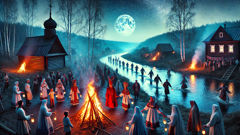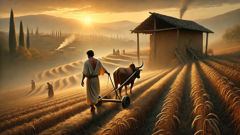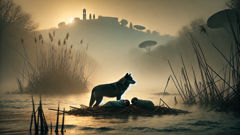Introduction
Long before maps and parish records, when people still took the language of wind and birch leaves for gospel, elders sat by red-amber fires and told the sky’s family story. In the hush of snow or the last warm breath of harvest evenings, mothers hummed the same refrain that stitched roofs to horizon: once the Sun and the Moon were kin, and the Stars were their scattered children, and because of a quarrel the world learned seasons, shadows, and the art of longing. This tale belongs to fields and hearths, to river ice and threshing floors—an origin told in many accents across wide forests and open steppes. Here it will be shared as a single woven cloth, stitched from the threads of many village songs and whispered variations. You will meet the Sun as a bold, wanderer-king, the Moon as a reflective sister with a private grief, and the Stars as the household of scattered lights—children and servants who keep watch and bear witness. Through their pursuits the earth learned to sleep and wake; through their jealousies the people learned to mark time, plant, and remember. The story that follows speaks of pursuit and protection, of a chase that shapes seasons, of bargains struck in frost and bloom, and of the rites by which humankind courted favor from a family that never truly sleeps.
Origins and the Kin of Light
Across Slavic lands, the story of how the Sun, the Moon, and the Stars became kin unfolds in many directions like a river spreading into marshes, and the first bend of that river is always about naming. In one telling, an old sky-woman—bereft of a home in some versions, a widow in others—gave birth to three: a bright, laughing boy who pulled himself across the light like a cart at dawn; a quiet daughter who learned to weave silver patterns on the black cloth of night; and a scatter of small bright things, children who loved to dance around their parents’ feet. In another telling the Sun and Moon were twins, split at the moment the world cooled: the male rising to burn with daytime promises, the female to guard the secrets of reflection and tides. The Stars, in both accounts, were younger—either the offspring of their kin or cousins sent from the older sky to keep company.

The family metaphor matters because Slavic communities spoke naturally in families; rivers were called grandfathers; horses had names reserved for the kin. When ancients imagined the sky in that register, they could explain why the Sun chased the Moon or why the Moon hung low and watched the sleeping fields. The language of kinship explains the Sun’s fierce protectiveness: he is father to light and relentless in his labor, and the Moon is both companion and rival, moving in arcs that sometimes mirror and sometimes counter his. Their quarrels became narratives used to teach children cause and consequence—do not take what is not offered, mind the obligations of hospitality, keep your hearth clean lest the bright ones pass you by.
Folktales differ by region but converge on motifs that ring true to agrarian life. In northern tales, where winters bite deep and days can be but a handful of golden hours, the Moon often plays the role of caretaker, lending pale light for night work and keeping watch over hunters. In southern steppes, the Sun’s temperament is emphasized: he is riding a chariot that strains to cross the wide blue, and when he slows or stumbles the harvest suffers. The Stars, small and many, are chroniclers and messengers; their patterns warn of wolves and good fishing, and their movements are stitched into wedding songs. Many versions describe how the Stars were placed in the sky as a kind of reward or punishment—sent to bed early for some childhood mischief or placed high to guide travelers when roads fold into mist.
A delicate arc of interpersonal drama explains the rhythm of day and night. The Sun, proud and hungry for admiration, loved the wide-open world and heated the earth until crops swelled. The Moon, contemplative and secretive, loved reflection—lakes, mirrors, and the faces of sleepers. Once, according to one widespread telling, the Sun boasted that he could gift warmth without asking; the Moon replied that warmth without listening can scorch, and their words cut like winter wind. Wounded vanity turned to a chase: the Sun would pursue the Moon across the sky, and in their disorder the Stars spilled themselves as witnesses, scattering in patterns that became our constellations. The chase explains eclipses—moments when jealousies close like shutters—and meteor streaks were once called children falling from punishment or runaway sparks.
These myths were not idle fantasy. Practical knowledge hid beneath poetic skin: farmers could read the Moon’s fullness to know when to cut hay, fishermen charted star positions to set lines at night, and midwives timed births to certain phases for auspiciousness. Rituals grew around these motifs. In the orchard, people would mark the first harvest day by turning a pitcher to face the sunset in gratitude; in the winter, they hung strings of tin or bright cloth to catch starlight and confuse malevolent spirits. The astronomical served the agricultural, and myth became a mnemonic device for livelihood. When elders recited who owed who in the sky, they were also reminding the community of who owed neighborly favors below.
Finally, oral tradition gave the family of the sky very human ethical dilemmas. Stories describe bargains: the Moon asked the Sun for a moonbeam to mend a lover’s grief, or the Stars petitioned for a place to rest where their children could learn names. Bargains sometimes required a human intermediary—a clever hunter or a kind old woman—who would barter milk or bread to receive a tiny favor: a star’s promise of a safe path, a moonbeam to soothe a fevered child. Through these bargains the myth establishes reciprocity between sky and earth. People fed the memory of the sky with rituals, and in return the sky gave time and sign. In the final measure, the kinship of Sun, Moon, and Stars taught communities how to act—who to trust, how to keep promises, and how to read the world in motions of light and shadow.
Chase, Seasons, and the Living Rituals
The second part of the sky’s tale answers a question people have asked since they first planted grain: why do day and night replace each other like breath, and why do cold and warmth trade places across the year? The chase. In most Slavic tellings that chase is both literal and moral. The Sun chases the Moon because of pride, or because of a broken promise; sometimes he pursues to protect—when the Moon, who softens and reflects, lingers too long near hungry beasts. The chase maps to labor cycles: the Sun pursues to wake the world and to push crops toward maturity; the Moon’s retreats bring long nights for repair and storytelling. Villagers, watching wheat tilt and sap rise, read these celestial motions as the plot of a family drama.

Stories enlarge the chase into mythic episodes. A common narrative tells of the Moon hiding behind a cliff-shaped cloud to nurse a wounded lover; the Sun, furious, lashes out and burns a swath of sky, sending down a rain of sparks that becomes the first meteor shower. From this came bridal omens: if a girl saw a meteoric streak while sweeping her threshold, she would know a suitor hovered near; if a farmer noted a sudden brightening in the east, the elders warned of a short spell of frost. Such tales are not simple superstition but a cultural method of linking observation with consequence: the sky’s impatience signals change in weather and fortune. In that way myth functions as local cosmology and survival guide.
Seasonal festivals crystallized from these tales. In spring, communities enacted the Sun’s return with fire rites: bonfires lit at dusk, wreaths floated down rivers as a plea for the Sun’s favor, and songs that mimicked the Sun’s golden laughter were sung. Young men and women would enact the chase in masked dances, one representing the Sun—a red-clad figure with a mirror shield—and another the Moon—silvered, gliding—while the chorus of Stars, children with pinprick lights, moved between them. In autumn, when the earth grows heavy with harvest, rituals turned to appeasement: offerings of newly baked bread and salted fish were placed on thresholds so the celestial family would not be jealous and take more than given. These practices reinforced community bonds; they were a social technology for cooperation during times when weather could turn neighbor against neighbor.
The myth also shaped moral teachings. The Sun’s heat was a lesson in restraint: generosity must not become consumption. The Moon’s reflection taught people to listen: brightness alone could not reveal everything. Stars taught humility: many small beings together outshine one alone. Russian lullabies and proverbs recalling these motifs have survived: small refrains that say, in effect, do not boast like the Sun, do not hide like the Moon, and do not scatter like the unanchored Star. They guided personal conduct—modesty, attention, and community-mindedness. Elders used this moral grammar to resolve disputes; for example, when two households argued over grazing rights, an elder might remind them of the Sun’s fury at reckless taking, and the memory of the celestial family would restore perspective.
Astronomical knowledge and myth braided tightly. Shepherds read the positions of certain stars to decide when to move flocks; fishermen timed nets to lunar phases; women used moonlight to dye cloth in specific ways because certain colors glowed truer under particular phases. Storytellers reinforced these practices by making them part of narrative consequence: in one tale a girl who refused to heed a star’s direction got lost and returned only after promising always to mark her path by chalking birch trees. The myth thus naturalized technology: ways of reading light and shadow were passed down not as abstract maps but as family admonitions.
Even hardship finds a form in these myths. Eclipses, when the Sun and Moon briefly obscure one another, are narrated as reconciliation and as warning. Villagers might huddle under hay sheds, banging pots and chanting to remind the sky that kinhood matters—that even if jealousies flare, order must return. In winter, when the Sun withdraws and nights stretch like old cloth, the Moon’s pale face becomes a solace. Songs, kept alive through baked goods placed on windowsills and charms pinned to collars, remind people that the family of the sky is nothing without memory. These songs are maps: they teach which star marks the safe route home, which lunar phase favors a birth, and which constellation foretells a heavy spring. In such ways the celestial family remains embedded in daily life, a living archive of weather, kinship, and communal decision.
Finally, in contemporary retellings the cosmic family is not merely mythic but a mirror. Poets and painters borrow the old quarrels to speak of modern estrangements—city lights that hide the stars, people who forget to look up—while rural communities still hold to seasonal rites that carry both pragmatic and sacred meanings. The myth persists because it answers more than what is overhead: it gives humans a vocabulary for relations, a script for timing life, and a ritual grammar for negotiating abundance and scarcity. The chase continues each day not only across the sky but in the stories we tell about our lives: of pursuit, of protection, and of the small luminous acts by which families—human and celestial—keep one another from vanishing into cold night.
Conclusion
When you stand under a cloudless Slavic sky and name the bright points by old songs, you are touching a history that taught communities how to live. The Sun, the Moon, and the Stars are never only bodies of light in these tales; they are relatives with temper, mercy, and reason. Their narratives were practical: windows onto weather, maps for planting, signals for travel, and moral fables to teach restraint and attentiveness. Equally, they were intimate—mothers hummed them to children, brides tucked fragments into kerchiefs, and hunters whispered them at the edges of forests. Even now, as city lights drown some constellations and calendars replace seasonal markers, the myth keeps working, not only explaining the sky but explaining us. It asks how we pursue one another and what we do when someone wanders and cannot find the path home. It asks whether we will hold to neighborly rites that feed the memory of the world, and whether we will, like the Stars, learn to shine together so that the smallest light can guide a traveler. In honoring those questions, the Slavic tale of the Sun, the Moon, and the Stars continues to live—bright, cool, and insistently present above our thin human plots of land.













